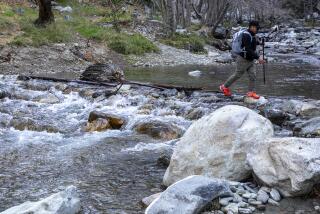Storms Leave Area’s Trails in Rocky Shape
- Share via
January’s rain wiped out major stretches of popular hiking and biking trails throughout the Angeles National Forest, and it could be many months before repairs are made because of budgetary problems.
Huge oak, fir and bay trees toppled across trails. Displaced boulders and rocks block the dirt paths. Overflowing rivers and streams washed away miles of trails, making hiking treacherous, if not impossible, in some canyon bottoms.
“I wouldn’t cross a lot of those streams right now,” said Julie Molzahn, a U.S. Forest Service official who oversees part of the trail system. “They are deceptively deep and swift.”
Last week, a 25-year-old Upland man was killed when he fell into the rushing Baldy Creek and was swept over a 40-foot waterfall.
So far, no trails have been closed officially, although the Forest Service is issuing “hiker alerts.”
“The forest, as opposed to a county park, is supposed to be a place where people can find a physical and mental challenge,” said George Duffy, who manages the 96 miles of trails in the Mt. Baldy District at the eastern end of the Angeles. “That is one of the primary reasons we don’t close the trails when the going gets tough.”
Many of the trails are still passable, but they narrow in spots, which means hikers may have to scramble over slippery rock slides or downed trees.
Duffy said that the Forest Service will “have to rely on the good graces of volunteers” to repair the most heavily damaged trails. “They are the only salvation.”
Damage was especially bad in the “Front Country,” the southern slopes of the San Gabriel Mountains overlooking the area from San Fernando to Claremont. In Arroyo Seco Canyon, north of Pasadena’s Rose Bowl, a four- to five-mile stretch of the historic Gabrielino Trail was knocked out. Floodwaters and slides overwhelmed trails in Little Tujunga and Big Tujunga canyons, north of Sunland and Lake View Terrace.
A half-dozen trails, most of them in the San Gabriel Wilderness and the Sheep Mountain Wilderness regions, were almost completely swept away by flooding in the Mt. Baldy District.
The Santa Monica Mountains National Recreation Area was also hard hit. Between 85 and 100 miles of trails in the 17,000-acre preserve sustained moderate to heavy damage from slides and severe erosion, said facilities manager Mike Molling. He estimated that the damage would cost $70,000 to $100,000 to repair.
“Right now, that money is not in my budget,” he said.
Many mountain streams are running high, boding ill for the trails because the rainy season is not over.
“We could have major problems by the end of the wet season,” said Cam Lockwood, the Forest Service official who oversees the entire Angeles system of trails, some first laid out by Indians centuries ago.
Compounding the problem is a budget far outstripped by the task ahead. The cost of repairing the trails in just two of the forest’s five districts will be almost as much as this year’s entire $260,000 trail budget, U.S. Forest Service officials say. Damage assessments in the other three districts won’t be complete for another week.
Outdoor enthusiasts complain that trail maintenance has been deferred for years because Forest Service officials have robbed from the trails budget to finance unrelated projects.
Forest Service officials “have simply decided that other things are important,” said Charlie Jones, founder of the San Gabriel Mountains Trail Builders volunteer group. As a result, he said, he has seen a steady deterioration of the forest’s 561 miles of trails.
Angeles Forest officials acknowledge that the trails budget has been drastically cut from its level of a decade ago, but they say they are managing their financial resources as best they can.
Most of the present $260,000 budget goes for trail signs, publications, coordinators for trail volunteers, fire patrol, equipment and environmental assessments of the impact of trail work, Lockwood said.
Ten years ago, each of the five Angeles Forest districts had a full-time, paid trail crew of eight to 10 members. Now there are only summertime crews with three to four members. Forest Service officials and the agency’s critics agree that if it were not for the volunteer corps of 700 trail builders, the mountain paths would not be repaired for years.
“For the most part, without the volunteers, you wouldn’t have a trail system today,” said Angeles Forest official Don Gilliland.
More to Read
Sign up for The Wild
We’ll help you find the best places to hike, bike and run, as well as the perfect silent spots for meditation and yoga.
You may occasionally receive promotional content from the Los Angeles Times.






